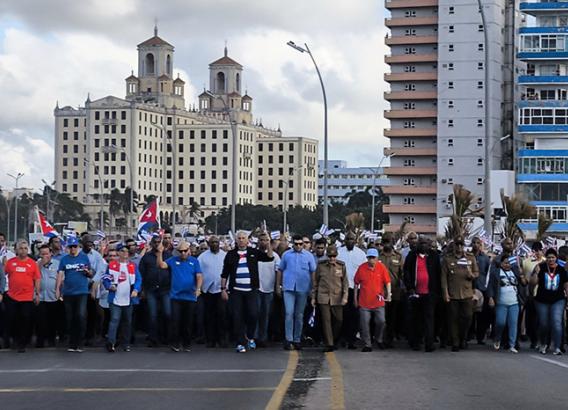Doping and Corruption in Sports: Why We Should Care, and What We Should Do
especiales

In December of 2014, a German TV channel, Das Erste, released a documentary alleging that a “majority” of Russian track and field athletes—up to 99% as claimed by one whistleblower—had been illegally doping, and implicated Russian Athletics Federation (RAF) officials with covering up the abuse. The alleged scheme was simple: in exchange for 5% of an athlete’s winnings, the Russian Anti-Doping Agency (RUSADA) would supply athletes and doctors with performance enhancing drugs (PEDs), and RUSADA and the RAF would protect athletes against positive tests through a combination of tip-offs, false identities, and clean urine.
In response to the allegations, Russian and international authorities were quick to express outrage and condemn any wrongdoing. The RAF threatened legal action against what it deemed “slanderous allegations,” while the International Association of Athletics Federations (IAAF) and the International Olympic Committee (IOC) promised to investigate. Last month, however, Lamine Diack, the president of the IAAF, was placed under criminal investigation by French authorities for allegedly taking 200,000 Euros in bribes to cover up positive Russian doping tests, despite having previously referred to allegations of systematic doping and corruption as “a joke.”
The full scope of the scandal was substantiated in an exhaustive report issued by the World Anti-Doping Agency (WADA) on November 9, 2015, which not only implicated high level officials at the RAF and IAAF, but also Russian government officials in the Ministry of Sport, and even the FSB, the modern-day successor to the KGB. While doping scandals may be most commonly thought of as a few bad apples cheating to win, the WADA report made it evident that this was a full-blown state-sponsored corruption scheme that profited public officials, and as such should merit the attention of the anticorruption community.
This scandal offers several takeaways for the anticorruption community:
- First, public officials can be actively involved in doping scandals. While discussions of corruption in sports often centers around bid rigging for massive events like the FIFA World Cup or the Olympics, the state-sponsored nature of the Russian scheme shows that the issue of doping can also implicate corruption. While there are relatively few conclusively proven cases of public officials’ participation, other scandals raise ample grounds for suspicion. For example, in 2006, a Spanish doctor named Dr. Eufemiano Fuentes was caught with an elaborate blood doping ring, after being ousted by a former cyclist client. The whistleblower also implicated several high-profile soccer players with doping through Dr. Fuentes, but in a strange twist, a Spanish judge ordered the bags of blood to be destroyed before the identities of the athletes were conclusively determined, justifying the decision on privacy grounds. While wrongdoing of public officials was not conclusively found, this scandal certainly does not alleviate Spain’s reputation for being soft on doping. After the publication of the WADA report, Dick Pound, the former President of WADA acknowledged this grim reality in saying, “It simply can’t be only Russia, and only athletics.” In calling into question the integrity of public officials and judges, these scandals implicate a very real public interest.
- Second, as discussed in a prior post on the blog, sports scandals are an extremely visible, public issue, with the potential to captivate the public and attune them to corruption issues on a broader scale. Given the popularity of sports, exposing corruption at high levels has the power to draw public ire related to entrenched cultures of impunity, and demand greater transparency and accountability in other areas as well. The involvement of state officials can be particularly problematic in developing countries or those with repressive regimes, where governments invest substantial sums of money into their athletes in hopes of gaining some legitimacy through their athletes’ glory and success. If more high-ranking officials are implicated in such schemes, there could be positive spillover effects in reducing the legitimacy of corrupt officials generally.
- Third, the current system can benefit organized crime. In 2013, an Australian government report found that organized crime groups were actively supplying Australian athletes with performance enhancing drugs. David Howman, the director general of WADA argues that under the existing testing regimes, the trade of illicit PEDs—and with it the potential for match fixing—has skyrocketed, most of it controlled by organized crime. As Howman aptly put it, “If you don’t think the mafia are involved here, you’re in fairyland.” Insofar as government officials may be complicit in these schemes, the involvement of organized crime is troubling in establishing links between public officials and criminal syndicates.
- Fourth, this situation sheds light on how poor institutional design can breed corruption. Most international sports are governed by confederations of national associations (for example FIFA for soccer, the IAAF for athletics, and FINA for swimming). While testing is carried out by nominally independent agencies like RUSADA, the responsibility to discipline athletes is often vested in national associations like the RAF, who have every incentive to ensure their athletes succeed, and may be subjected to pressures from government officials. In the case of Spanish cyclist and former Tour de France champion Alberto Contador, this lack of independence was readily apparent. Contador tested positive for the steroid clenbuterol, and was ordered to a 12-month ban on competition by the Spanish Cycling Federation (RFEC). However, after the Spanish Prime Minister came out publicly in favor of Contador, RFEC withdrew its 12 month ban, which was only reinstated after WADA appealed their decision to the Court of Arbitration for Sport. The Spanish case shows the problems with the aligned incentives of national federations and their athletes. Though the nexus to public officials may not always be conclusively established, the governance of sports offers a valuable case study in how to institutions can either be conducive or resistant to corruption.
The existing system could be strengthened in the following ways:
- First, the power of administering testing must be taken away from those with any incentive to cover up wrongdoing. National doping agencies are too easily controlled by national sports federations who have much to gain from their athletes’ success, and these federations are in turn susceptible to state pressures, as evinced by the Russian case. The system whereby the people responsible for catching dopers are also the ones who benefit from dopers’ performances must be changed. WADA and other independent, international organizations who do not have incentives to push for athletes’ victories should be better funded and their powers strengthened. Taking responsibility for drug testing away from national federations would insulate the matter of doping from public officials’ sphere of power, and thus reduce the likelihood of state-sponsored corruption schemes like that in Russia.
- Second, there must be better data and reporting related to doping. Some argue that to date, no reliable estimate of the prevalence of doping has even been published. Aside from actual convictions, discussion of doping in sports often relies on anecdotes and estimates, making it difficult to treat the subject with the importance it merits, especially given the high monetary and non-monetary stakes involved in both professional and amateur sports. To assist these efforts, incentives for self-reporting and whistleblowing should be increased, and athletes coming forward with evidence of doping schemes should be protected and rewarded.
- A final, though far more radical approach is to partially legalize doping, an idea which is gaining some traction among ethicists and other commentators (see here, here and here). Though the principal aim of such a measure goes far beyond the scope of preventing corruption and abuses of power, doing so might reduce opportunities to cheat, and simultaneously opportunities for corrupt schemes to profit from the illegal activity.
Though doping to tilt the playing field in one’s favor may seem like little more than a victimless cheating, corruption scandals in sport have effects that reach far beyond the confines of the stadiums and playing fields. Doping scandals can offer valuable lessons to the anticorruption community broadly, and addressing them could have the positive side effect of helping to stymie entrenched cultures of corruption.













Add new comment